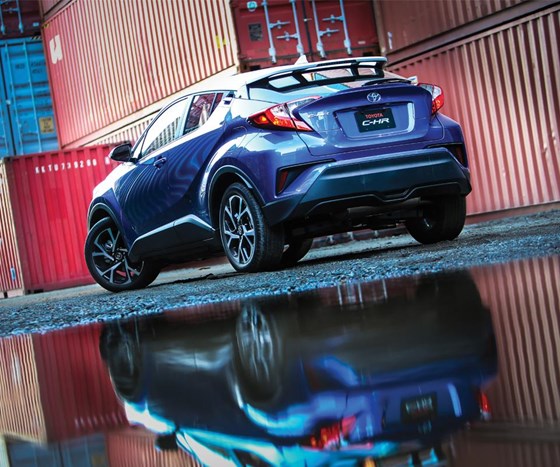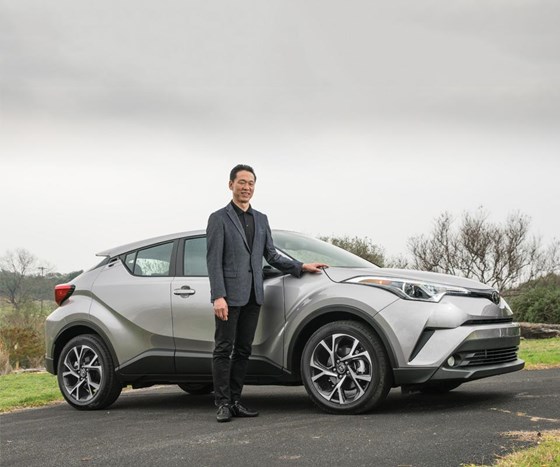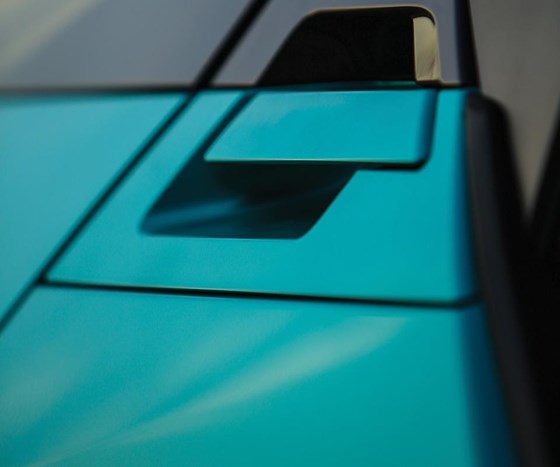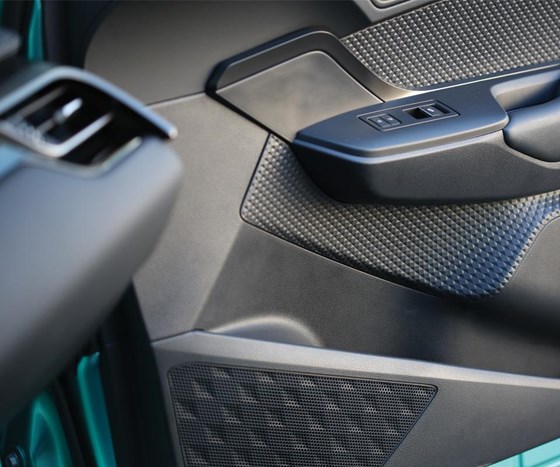
Yes, that’s a Toyota: the 2018 C-HR. No, it doesn’t look like anything that’s come from that brand
(at least since the 2000 Celica).

This is the Scion Concept revealed in 2015 that was transformed to the production 2018 Toyota C-HR. (Because Scion no longer exists.)

Top engineer on the C-HR, Hiroyuki Koba, wanted to make sure that the small crossover had spirited driving characteristics, so he took it to the Nürburgring Nordschleife and drove it. (Yes, he’s a driving enthusiast.)

To achieve more coupe-like styling, the rear door handles are disguised, located high on the C-pillar. According to Koba, engineering the handles was a non-trivial task.

There is a diamond theme both inside and out on the C-HR. Note all of the diamond shapes in this one area of the interior.
Previous
Next
Related:
Automotive Body
Automotive Design
Automotive Engineering
Automotive Powertrain
Automotive Production
When the production version of the 2018 Toyota C-HR compact crossover was introduced for the first time at the 2017 LA Auto Show, then-Toyota Div., Toyota Motor Sales U.S.A., group vice president and general manager, Bill Fay said, “It looks like nothing we’ve ever created.†As a Toyota.
At the 2015 LA Show a concept car had been revealed, the Scion C-HR. And at the time then-Scion vice president Andrew Gilleland said, “Scion is known for doing things differently, and maybe even being a little weird. This C-HR Concept embraces that idea and wears it like a badge of honor.â€
The Scion C-HR was a concept with the obligatory exaggerated wheels and tires and character lines. And by August 2016, Scion ceased to exist.
That said, the C-HR continued on. It became a Toyota. Of course, there were some modifications and the concept became real. Even in terms of what the “C-HR†stands for. At first, it was “Compact size with High Ride height.†It is now “Coupe High Rider.†(Although it should be pointed out that whereas a “coupe†is generally defined as a car with two doors, the C-HR has four doors. But there are two aspects of that which need to be taken into account. One is that there is a sloping roofline, which is more coupe-like than sedan or even crossover-like (it really is a crossover, not a car, which accounts for the accurate “High Riderâ€: the C-HR is based on the same TNGA architecture—that’s Toyota New Global Architecture—that underpins the current-generation Prius. The Prius has a ground clearance of 5.1 inches. The C-HR has a ground clearance of 5.9 inches.) and the engineering team did a clever job of creating a door handle for the rear doors of the C-HR such that they are nearly invisible on the C-pillar.) Still, as Fay had said, it looks like nothing that has had a Toyota badge.
And while it may be toned down from the Scion C-HR Concept, it is clearly an exercise in doing something significantly different for Toyota.
Engineered to Drive.
One thing that chief engineers of all brands like to do is to develop vehicles that bring them to Germany, specifically to the Eifel mountain region and more specifically to the Nürburgring Nordschleife. And Hiro Koba, deputy chief engineer, who led the development efforts for the C-HR, is no different. Yes, he took the C-HR to Germany, to the circuit, in 2013. This helped them supplement the structure with welds, adhesives and braces. It helped them come up with the tuned suspension for the vehicle, which features MacPherson struts with SACHS dampers in the front and, at the rear, an all-new double-wishbone suspension that utilizes a 26-mm stabilizer bar and SACHS dampers with urethane upper supports, which is a first for Toyota.
There is an electric power steering system; its rack-and-pinion gearbox is mounted directly to the front suspension for high rigidity.
The Powertrain.
The C-HR is a front-drive car. It has a 2.0-liter four-cylinder dual-overhead cam engine and a continuously variable transmission. The engine produces 144 hp @ 6,100 rpm and 139 lb-ft of torque at 3,900 rpm. The engine features variable valve timing (VVT) and “Valvematic,†which is on the intake side of the engine: it provides continuously variable lift and phasing based on engine demand.
The transmission is designated the CVTi-S, with the “i†standing for “intelligence†and the “S†shift mode: because of the sporty nature of the C-HR it offers a Sport mode that adjusts the throttle and “shift†points (remember that the CVT has belts and pulleys, not gears) and the transmission allows manual shifting.
Shine On.
The design theme for the C-HR is “Distinctive Diamond.†Arguably, this is not so much about the gemstone as an expensive object as it is about the geometry of the shape, not only the four-sided diamond, but the facets that are characteristic of the finished rock. There are a series of sharp character lines and shapes that start with the narrow headlamps and transition all the way out to the functional cantilevered wing on the rear hatch. The exterior styling for the vehicle was done at Calty in Newport Beach.
On the inside of the car—which was designed at the Toyota studio in Nice, France (the production design was completed in Japan)—there is a certain simplicity. The instrument cluster is curved so that it addresses the driver; the center stack, including a 7-inch screen, is angled toward the driver, as well.
No Navi. But Safety.
One interesting aspect of the C-HR is that because it had originally been a Scion (at least for the U.S. market—remember, Scion didn’t exist elsewhere, so in other markets it would be a Toyota from the start (the vehicle is being built in two plants—Sakarya, Turkey, for markets including the U.S., and Iwate, Japan, for the Japanese and other markets), it doesn’t have the tech that one might expect. Like a navigation system. But because it is a Toyota, it has full-on safety technology.
Standard is Toyota Safety Sense P. That’s a package containing pre-collision with active braking and pedestrian detection; lane departure alert with steering assist; automatic high beams; and full-speed range dynamic radar cruise control.
When Bill Fay announced the Toyota C-HR in LA, he pointed out that the compact crossover segment is expected to have sales on the order of 1-million. While Toyota is getting its share of that segment with the RAV4, which is now in Camry-Corolla sales space, certainly the C-HR will provide a boost, drawing in those people who are of a demographic that might not have ever considered Toyota brand as a possibility. Â Â








